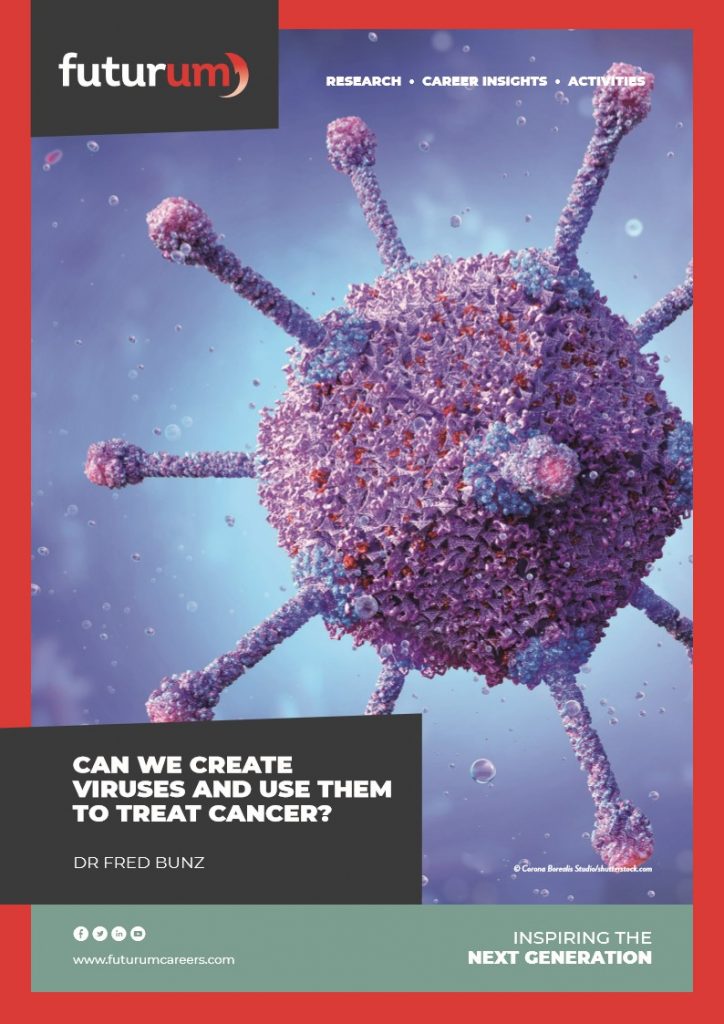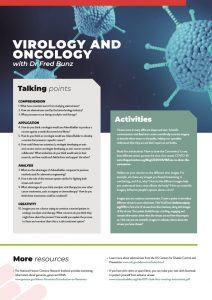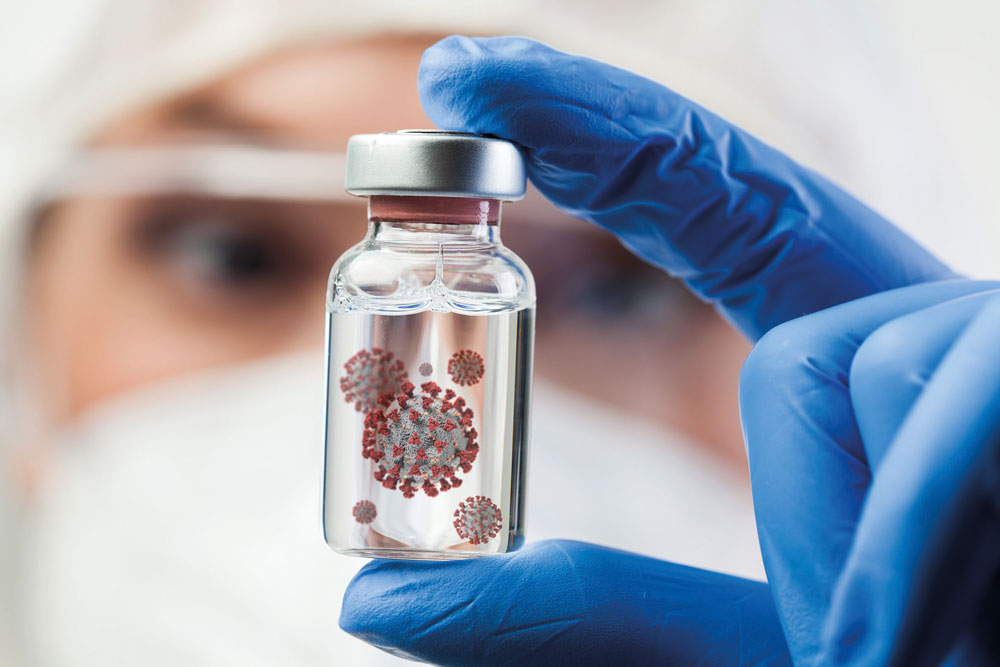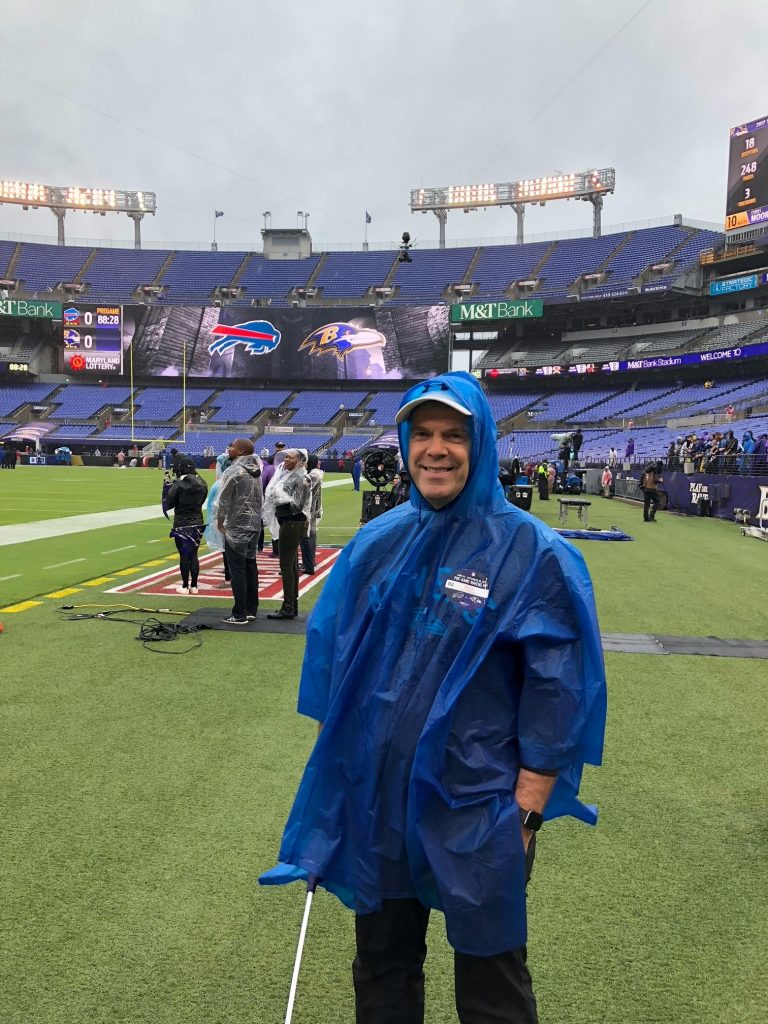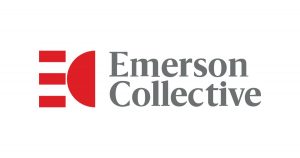Can we create viruses and use them to treat cancer?
Viruses can cause cancer, but they also have the power to cure it. Dr Fred Bunz is a molecular oncologist at Johns Hopkins University School of Medicine in the US. He has developed a new technique that enables scientists to build adenoviruses in the lab, paving the way for new discoveries in the field of virology and new treatments for cancer patients.
TALK LIKE A VIROLOGIST AND ONCOLOGIST
Adenovirus — a virus that typically causes sore throats, respiratory conditions or conjunctivitis
Cultured cells — cells grown under controlled conditions in a lab, commonly used to diagnose infections or test new drugs
DNA (deoxyribonucleic acid) — the double-stranded molecule that carries genetic information in living organisms
DNA recombination — the technique of rearranging genetic material
Gene therapy — a technique that modifies someone’s genes to treat or cure diseases
Genome — the complete set of genetic material in an organism
Oncology — the study of tumours and cancer
Replicate — to make an exact copy of something
RNA (ribonucleic acid) — the single-stranded molecule that carries genetic information in some viruses
Virology — the study of viruses
Adenoviruses are a family of viruses that cause a wide range of illnesses. These are mostly mild infections, causing sore throats, respiratory conditions and conjunctivitis, or ‘pink eye’. “By adulthood, most people have been exposed to at least one strain of adenovirus and have thereby acquired immunity,” says Dr Fred Bunz, an oncologist who studies adenoviruses at the Johns Hopkins University School of Medicine.
Why are adenoviruses useful?
Adenoviruses are a remarkably useful tool for scientists to use in labs, as they are safe to handle and easy to propagate. “They have become workhorses for the biotechnology industry and for biomedical research,” says Fred. “Much of what we have learned about basic molecular biology, such as RNA splicing and DNA replication, arose through studies of adenoviruses.” While adenoviruses are still used in basic biological research, scientists have also started to use them for gene therapy and vaccine development. For example, adenoviruses were recently in the scientific spotlight as they are used in the COVID-19 vaccines developed pharmaceutical companies Janssen and Oxford-AstraZeneca. These adenoviruses have been engineered to deliver a crucial component of the SARS-COV-2 virus, thereby training the immune system to recognise this dangerous pathogen effectively.
All viruses contain genetic material composed of a type of nucleic acid, either DNA or RNA. “Unlike the viruses that cause influenza and COVID-19, which contain RNA as their genetic material, adenoviruses are based on DNA,” says Fred. As early as the 1970s, scientists started finding ways to manipulate large DNA molecules. “Scientists discovered that they could grow adenovirus genomes in bacteria, and then transfer their DNA to cultured human cells to recreate infectious viruses,” says Fred. “This was a remarkable accomplishment.” In nature, viruses replicate themselves, but by using this technique of DNA recombination, scientists can bypass the replication stage and create viruses directly from adenovirus DNA in the lab.
How can scientists build adenoviruses?
Fred is taking the process of DNA recombination a step further. Using a technique he first developed in 2018, he has created a recombinant DNA technology platform called AdenoBuilder. “AdenoBuilder allows scientists to assemble adenovirus genomes in modular fashion, from relatively short pieces of synthetic DNA,” Fred explains. “These short DNA pieces are essentially ‘building blocks’ that can be stitched together to create a complete strand of viral DNA.” The DNA is assembled in a test tube with the help of commercially available enzymes. Then, the resultant genome is inserted into a protein shell, known as a capsid, and delivered to cultured human cells in a lab.
What are the benefits of AdenoBuilder?
“Older methods of adenovirus engineering involved maintaining the entire adenovirus genome in bacteria,” says Fred. However, it is challenging to manipulate large DNA molecules, and many research labs around the world do not have the capabilities to achieve this. As AdenoBuilder assembles the adenovirus genome from small DNA units, they are much easier to handle and so virtually any biology lab can do this. “The assembly is performed in a test tube, so the bacterial step is bypassed entirely,” Fred explains.
Reference
https://doi.org/10.33424/FUTURUM384
With AdenoBuilder, each building block of DNA can be individually modified before it is added to the genome. In a single assembly, Fred can create a virus with multiple genetic alterations in different areas of the genome and can quickly generate many different adenoviruses. This was not possible before, as older methods required changes to be made one at a time. “With AdenoBuilder, we can generate new and useful viruses at a rate that would have been unimaginable just a few years ago,” Fred adds.
What challenges did Fred face?
“Compared to human DNA, viral DNA contains many repetitive elements and regions that are highly structured,” says Fred. Therefore, viral genomes are extremely difficult to work with. The main challenge Fred and his team faced when creating AdenoBuilder was to discover which segments of the adenovirus could be copied and stably maintained in a circular DNA molecule. It was also a challenge for the team to determine the optimal conditions necessary to create a sufficient amount of the full-length DNA from the smaller building blocks.
What is next for AdenoBuilder?
One particularly exciting aspect of AdenoBuilder is its ability to incorporate millions of tiny changes in a large population of virus particles. Fred calls these ‘virus libraries’. “Going forward, our plan is to search through these libraries for rare recombinant viruses with new features and capabilities,” says Fred. “This discovery process is comparable to someone sifting through silt to find small flecks of gold.”
Fred is also excited to use AdenoBuilder to help treat cancers. His primary research interest is not, in fact, virology, but oncology. “However, these two fields are intimately related,” he explains. “Oncologists are starting to realise that infecting cancerous tumours with specifically engineered viruses can be an effective form of therapy.” Fred hopes his work will not only advance the field of virology but will also lead to new treatments for people with cancer.
 Dr Fred Bunz
Dr Fred Bunz
Associate Professor of Radiation Oncology and Molecular Radiation Sciences, Johns Hopkins University School of Medicine, USA
Fields of research: Oncology, Virology, Immunology
Research project: Developing a biotechnology platform to create adenoviruses for scientific research
Funders: This work is supported by the US National Institutes of Health (NIH), under award number GM135485, and the Emerson Collective. The contents are solely the responsibility of the author
About virology and oncology
Scientists have recently realised that viruses have the remarkable power to both cause and cure cancer. Some viruses, such as the human papilloma virus (HPV), cause cancer, but scientists can now manipulate unrelated viruses to prevent or kill a variety of cancerous tumours.
“There are remarkable parallels between virology and oncology,” says Fred. The immune system fends off both viruses and cancer. While we all regularly encounter viruses, it is only on occasion that they make us sick. “This is because our immune systems are highly efficient at recognising viruses and clearing infected cells before an infection can cause trouble,” Fred explains. Only a small number of viruses successfully evade our immune systems, and these are the ones that make us ill.
“In this respect, cancer is very similar,” says Fred. It is common for abnormal cells to grow in our bodies, particularly in areas with a high rate of cell turnover, such as our skin and the lining of our gut, but our immune systems are good at monitoring these areas and removing abnormal cells before they spread. Sometimes, however, a group of abnormal cells will go undetected and grow into a tumour, which may become cancerous. Currently, scientists are developing vaccines that can stimulate the immune system to prevent cancers or to suppress their growth.
How can viruses treat cancer?
Cancer cells contain genetic defects that make them particularly fertile places for viruses to grow. “Scientists can exploit this vulnerability,” says Fred. One method for this is oncolytic viral therapy, a form of cancer treatment in which cancer cells are infected with an engineered virus. Adenoviruses are well-suited to this task. “In the normal adenovirus life cycle, the virus continues to replicate within the infected cell until the cell literally bursts,” Fred explains. Oncolytic viral therapy takes advantage of this process, as the engineered virus will infect the cancer cells and cause them to burst open.
As well as killing the cancer cells, the presence of the virus also jolts the body’s immune system into action. “The combination of these two effects, the direct killing of cancer cells and the stimulation of a dormant immune system, can unleash an effective immune response against cancer,” says Fred.
Pathway from school to virology and oncology
• At school and post-16, science and mathematics will teach you the foundational knowledge needed for further study of virology or oncology.
• At university, undergraduate degrees in biology, biochemistry, molecular biology, biomedical science or medicine could lead to a career in virology or oncology. “I studied biochemistry,” says Fred, “but some of the best biomedical scientists I’ve encountered studied mathematics at university.”
• Fred recommends taking courses that challenge you and force you to grow intellectually. “There is no ideal curriculum,” he says. “Challenging courses in the humanities are just as important as science subjects. Being a successful scientist requires an ability to think broadly about a great variety of subjects.”
• It is important for scientists to communicate their findings with others, both in and outside their specific research field. “You have to know how to write,” advises Fred, so take courses in scientific writing and communication.
• Try to get hands-on lab research experience. Johns Hopkins University School of Medicine provides opportunities for high school student to explore biomedical careers: www.hopkinsmedicine.org/som/pathway/high-school-student-resources
Explore careers in virology and oncology
• Working in virology and/or oncology will lead to an extremely rewarding career. You could conduct research at a university or for a biotechnology company, work with patients in a hospital or advise the government in a public health role. The COVID-19 pandemic highlighted the importance of these roles for developing vaccines, monitoring viral outbreaks, studying viruses and developing the policies to protect communities.
• The Royal College of Pathologists provides information about what virologists do: www.rcpath.org/discover-pathology/careers-in-pathology/careers-in-medicine/become-a-virologist.html
• The Royal College of Radiologists features interviews with experienced and trainee clinical oncologists: www.rcr.ac.uk/clinical-oncology/careers-and-recruitment/thinking-about-career-clinical-oncology/what-it-really-be
Meet Fred
Have you always been interested in medicine?
Growing up during NASA’s Apollo era, I was fascinated by space travel and immersed myself in science fiction. I couldn’t imagine a more interesting career than that of a scientist – I still can’t! My interests in biology and medicine emerged later, when I was able to appreciate the impact of these fields on the lives of ordinary people.
What inspired you to study adenoviruses?
I first learnt about adenoviruses as a medical student, and I’ve always found them fascinating. We’ve known about them for decades, but they are still giving up their secrets. They have taught us so much about how human cells function. I could never have imagined that they would one day be used for cancer therapy.
What do you most enjoy about your work?
There are many aspects of my work that give me great satisfaction. I enjoy the freedom I have to pursue new ideas, and I greatly enjoy the process of developing a project that addresses an important question. Most projects fail, of course. But it is exciting when something works, or even better, when a successful project takes you in an unanticipated direction. At the end of the day, it feels good to be part of a greater enterprise that’s dedicated to improving the outlook for cancer patients.
What do you enjoy doing in your free time?
Science is not only my career, but also my hobby, and I enjoy reading about science in my free time. As I work in an office and lab environment, I try to get outdoors whenever I can, ideally with my family.
Fred’s top tips
1. Don’t be afraid to try hard things.
2. Don’t be afraid to fail. Failure lays the groundwork for success in the long run.
Do you have a question for Fred?
Write it in the comments box below and Fred will get back to you. (Remember, researchers are very busy people, so you may have to wait a few days.)

